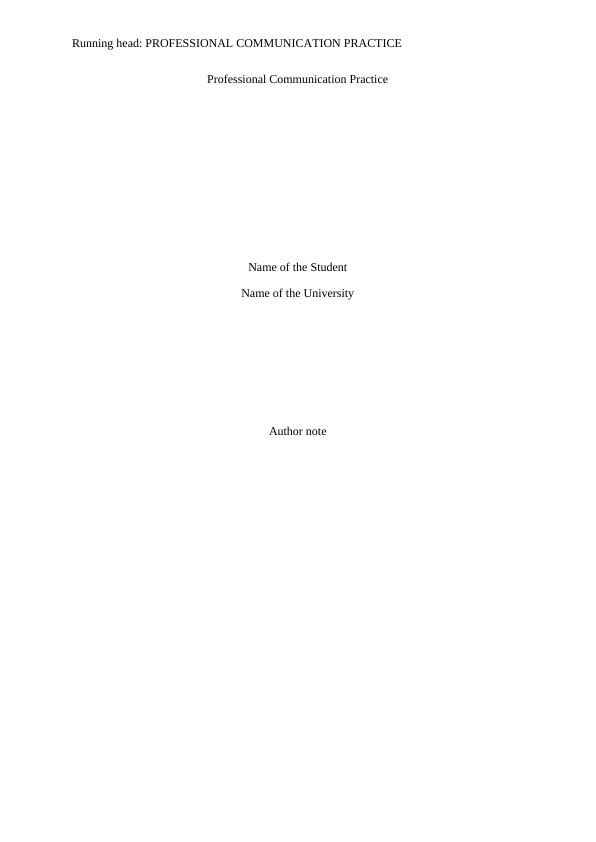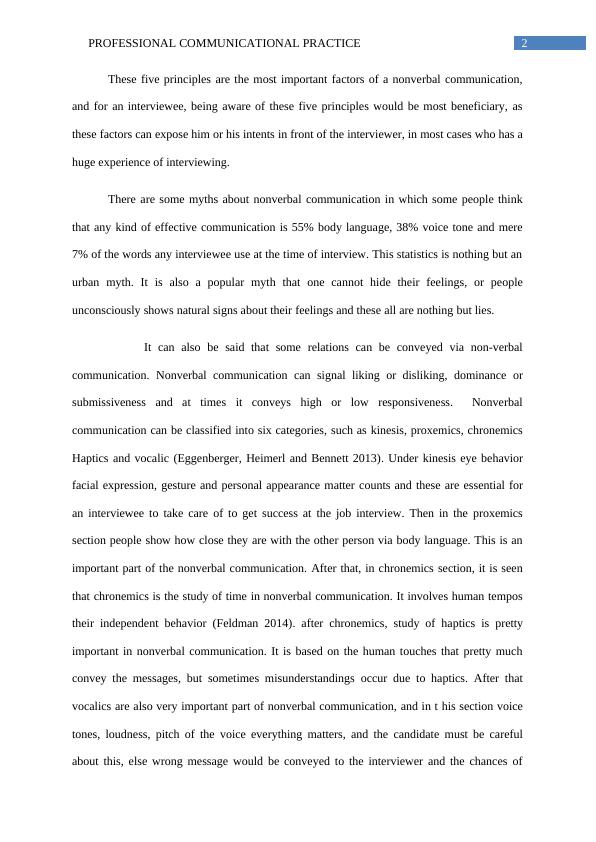Professional Communication Practice
8 Pages2046 Words149 Views
Added on 2020-02-24
Professional Communication Practice
Added on 2020-02-24
ShareRelated Documents
Running head: PROFESSIONAL COMMUNICATION PRACTICEProfessional Communication PracticeName of the StudentName of the UniversityAuthor note

1PROFESSIONAL COMMUNICATIONAL PRACTICEScenario 3 On a job interview, a candidate might think that he or she has all the relevant answersfor the questions the interviewer would ask and eventually he or she will get the job. In reallife getting a job is not that easy as nonverbal communication plays a big role behind gettingsuccessful in a job interview. The candidate’s body language, intonation, facial expressions,the attire of the candidate everything matters in a job interview. In some cases, nonverbalcommunication is seen more important than verbal communication (Knapp, Hall and Horgan2013). The interviewers observe the candidate’s nonverbal communication throughout theinterview and they will judge the candidate highly on its basis. It can be said that, non-verbal communication is an element of the in-personpresentation that caused to be the response when the responses matter the most. There arefive principle effects that a nonverbal communication must have and those are mentionedbelow.Repetition: Non-verbal communication can easily reinforce what has been alreadysaid.Substitution: Non-verbal communications can easily substitute words.Contradiction: Non-verbal communication can easily contradict the messages andcan project the speaker as a dishonest person (Irvine, Drew, and Sainsbury 2013).Accenting: Non-verbal communications can emphasize a specific point in themessage.Complementing: The non-verbal communication can complement most of the verbalmessages. For an example it can be said that patting on the back can be a sign of appreciation.

2PROFESSIONAL COMMUNICATIONAL PRACTICEThese five principles are the most important factors of a nonverbal communication,and for an interviewee, being aware of these five principles would be most beneficiary, asthese factors can expose him or his intents in front of the interviewer, in most cases who has ahuge experience of interviewing. There are some myths about nonverbal communication in which some people thinkthat any kind of effective communication is 55% body language, 38% voice tone and mere7% of the words any interviewee use at the time of interview. This statistics is nothing but anurban myth. It is also a popular myth that one cannot hide their feelings, or peopleunconsciously shows natural signs about their feelings and these all are nothing but lies.It can also be said that some relations can be conveyed via non-verbalcommunication. Nonverbal communication can signal liking or disliking, dominance orsubmissiveness and at times it conveys high or low responsiveness. Nonverbalcommunication can be classified into six categories, such as kinesis, proxemics, chronemicsHaptics and vocalic (Eggenberger, Heimerl and Bennett 2013). Under kinesis eye behaviorfacial expression, gesture and personal appearance matter counts and these are essential foran interviewee to take care of to get success at the job interview. Then in the proxemicssection people show how close they are with the other person via body language. This is animportant part of the nonverbal communication. After that, in chronemics section, it is seenthat chronemics is the study of time in nonverbal communication. It involves human tempostheir independent behavior (Feldman 2014). after chronemics, study of haptics is prettyimportant in nonverbal communication. It is based on the human touches that pretty muchconvey the messages, but sometimes misunderstandings occur due to haptics. After thatvocalics are also very important part of nonverbal communication, and in t his section voicetones, loudness, pitch of the voice everything matters, and the candidate must be carefulabout this, else wrong message would be conveyed to the interviewer and the chances of

End of preview
Want to access all the pages? Upload your documents or become a member.
Related Documents
Communication skills -Assignmentlg...
|22
|6392
|2324
Kinesics Communication: Understanding Non-Verbal Cueslg...
|6
|1479
|301
